W/O McIntaggart was serving with 20 Squadron (Facta Non Verba), out of Kalyan airfield, NE of Bombay (now Mumbai) India  . He lost his life when Hurricane aircraft KW 749 struck a hillside in bad weather near Khandala, India, en route to Poona (now Pune). The crash appears to have been near Khandala
. He lost his life when Hurricane aircraft KW 749 struck a hillside in bad weather near Khandala, India, en route to Poona (now Pune). The crash appears to have been near Khandala 
McIntaggart had previously been involved in an aircraft accident. On 3 February 1943 he was operating with #28 Squadron RAF in an army co-operation role, when returning from a Tac recce flight, his aircraft (Hurricane BW912) was diverted to Bawli Bazar, Burma. On landing he hit a soft spot on the aerodrome and the aircraft overturned. The aircraft was later repaired. And lost with another pilot.


